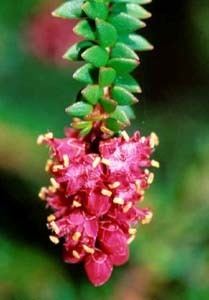Rank Species | ||
 | ||
People also search for Trochocarpa, Richea pandanifolia, Richea | ||
Trochocarpa thymifolia is a common montane and subalpine shrub from the plant family Ericaceae (originally Epacridaceae). Originally described by botanist Robert Brown in 1810, it is a widespread Tasmanian endemic that inhabits mountain regions. It is named after its characteristic thyme-like leaves, and due to its delicate pendulus flower-spikes is known colloquially as 'Delicate Trochocarpa'.
The species is synonymous with: Decaspora thymifolia and Decaspora oxycoccoides, and commonly confused with Trochocarpa parvifolia (current taxon: Acrotriche parviflora).
Description
Mature plants form erect, bushy shrubs, with small, densely-packed, ovate to elliptic leaves (2–4 mm long). Leaves are dark green, slightly lighter green on the underside, with parallel venation - a distinguishing characteristic of the Ericaceae family. Flowers possess 5 lobes, range from pink to red, and are 4mm in length. Inflorescences form dense, drooping terminal spikes 1.5 cm long. Fruits are spherical, fleshy, blue to purple in colour, and approximately 8 mm in diameter. Fruits and flowers are usually present simultaneously, creating stunning displays of contrasting colours and textures.
